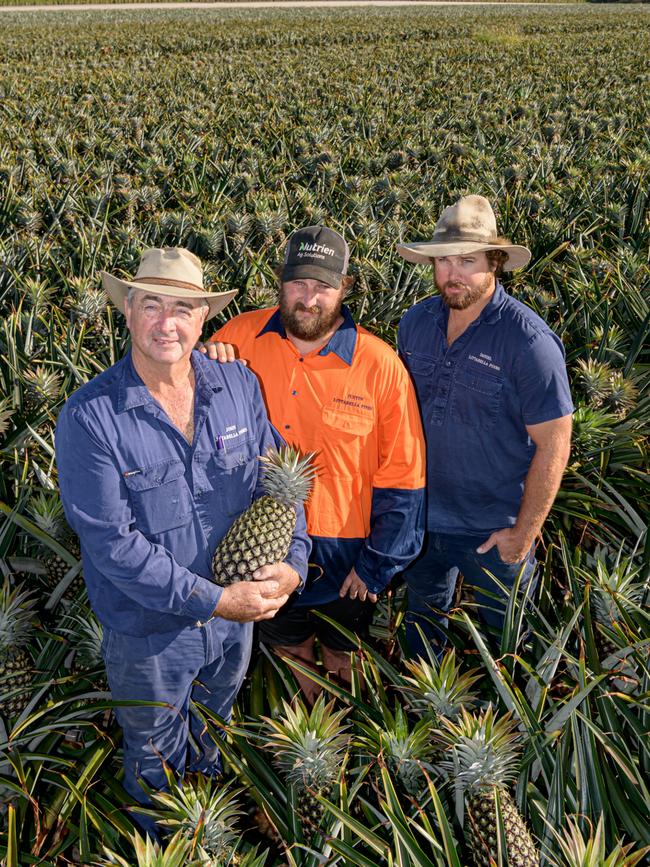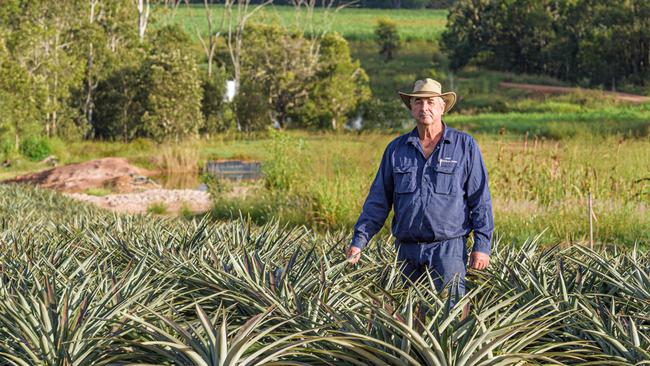Littabella Pines thrive with Steemson family drive
Instead of accepting declining production due to limited water, the Steemson family switched their primary crop and became the biggest in the business.

The Steemson family is proof that embracing change can have unimaginable benefits.
In 2002 when they planted their first pineapples as a drought strategy on their 1200ha property at Yandaran, 40km north of Bundaberg in Queensland, John and Linda Steemson had no idea that two decades later Littabella Pines would become the biggest supplier of canned pineapples in Australia.
Having farmed sugarcane, watermelon, pumpkin and sweet potato for decades, it was a gutsy move for the Steemsons to switch to pineapples but given their lack of irrigation, limited water storage capacity and drying conditions, it made sense to move away from heavily water-reliant crops to something more tolerant of extreme weather conditions.
Identifying their limiting parameters and finding a crop to match has seen the family business thrive.
Pineapples now make up 75 per cent of the business, sugarcane 15 per cent and watermelon and pumpkins 10 per cent.
John and Linda, who farm with sons Daniel and Justin, now employ 25 regular staff and produce 7000 tonnes of pineapples a year as well as 20,000 to 30,000 tonnes of sugarcane, 200 tonnes of watermelon and 200 tonnes of pumpkin.

Unseasonal weather threw the pineapple industry a curve ball earlier this year after a major natural flowering event caused a concentration of harvest in February.
“We harvested 2500 tonne in four weeks – something we’ve never had to do before,” John said, adding they would normally harvest between 600 and 800 tonnes in that time.
They invested in a second harvester worth $150,000 and hired 14 extra staff through the PALM Scheme to help.
Normally pineapple growers can control flowering by applying the natural hormone ethylene as a growth regulator, which helps dictate when fruit will be harvested.
However in May and June of 2022, a period of unseasonal cloudy and showery weather created conditions for Mother Nature to take control of growth, forcing plants to flower naturally and produce fruit that wasn’t intended at that time.
The ratoon crop – fruit from suckers that shoot after a crop’s first harvest – will also be harvested in a more condensed time frame, influencing supply and demand over the next few years.
“We just have to deal with it as best we can,” John said.
The Steemsons don’t have a regimented time frame for planting and picking but instead have an annual goal – two million plants a year at 55,000 plants per hectare, plus harvesting two million plants of ratoon crop.
“It is mainly about managing our labour in the most effective way so we don’t turn over staff – the guys are in full-time employment year round,” John said.
Forty hectares are planted to pineapples every 12 months that are harvested two years later as a plant crop and then again 18 months later as a ratoon crop. In some cases, sections of crop that are suitable can be fertilised and produce a second ratoon crop 15 months later.
Once the crop has been harvested, plant matter is mulched back into the soil as organic matter and nutrition for subsequent crops.
Raised beds and GPS levelling equipment are used to ensure good drainage and help manage water flow. Fertiliser is applied with foliar sprays and once plants are 18 months old, ethylene is applied to initiate flower production.
Six to eight months later fruit is ready to harvest.
Machines are used to help with planting and picking, but the process remains heavily labour intensive.
“We can harvest an average of about 70 tonne of fruit a day with 17 people,” John said.
“That would be about 3.5 semi-trailer loads with the average maiden pineapple about 1.5kg.”

Rather than growing hybrid varieties, the Steemsons grow smooth Cayenne pineapples as they process well and are ideal for canning.
Eighty per cent of their fruit is sold to Golden Circle and the balance to fresh markets.
Queensland is the only state currently producing commercial pineapples and Golden Circle is the only high volume processor. It recently provided growers with a welcome price rise for fruit.
They constantly evaluate how they can farm more efficiently yet remain sustainable.
“You need to have a good understanding of your costs and limitations particularly with pineapples – it’s 4.5 years from planting to planting,” he said.
“Before you plant your next crop you have to be confident you can still produce something that is more valuable than what it costs.
“Just because someone else can produce 100t/ha, in your growing system you might only be able to grow 90t/ha, so you need to be aware of your cost structure to accommodate a profit.”
The Steemsons cost of production increased by $10,000 a hectare in three years, up from an average $35,000/ha in 2019 to $45,000/ha in 2022.
In the past 12 months there has been further cost increases, including wages.
“We spent $1.6 million on labour last year. It is a very significant part of our business expense,” John said.
“Managing that labour cost is crucial.
“We constantly evaluate the operation – can we do it better, can we invent a machine to do something more efficiently, can we change the way we operate to reduce costs?”
With the Great Barrier Reef on their doorstep, the Steemsons have been actively involved in various research projects and trials being conducted by the pineapple industry in collaboration with the Queensland government, Growcom and private enterprises looking at ways to reduce environmental impacts such as sediment and nutrient run-off, water quality and soil erosion.
They were the first pineapple growers to achieve reef certification under the Hort 360 Reef Water Runoff Quality Program recognising environmental stewardship.
They have now completely changed their fertiliser program from granular to foliar and redesigned the overall nutrition program with very little pre-plant fertiliser now used on the pineapples.
They have also designed and built more effective machinery to apply foliar nutrition in smaller amounts more regularly at times of high growth to achieve more efficient outcomes.

Their most limiting factor for crops continues to be water – either too much or too little – and this year is no exception with “very dry” conditions.
The average rainfall at Bundaberg is 1200mm a year but they have received only 400mm since January when normally it would be about 1000mm.
“The sugarcane is struggling – we have a poor crop that will be two thirds of what it should be if we had reasonable weather conditions,” John said.
They harvest about 450ha of sugarcane each year supplying local mill, Bundaberg Sugar. Their long-term production average is 70t/ha but dry weather has seen that drop in the past five years to 55-60t/ha.
While pineapples are more tolerant of weather extremes, plants are showing effects of the dry, which may affect size and production in next year’s harvest.
The Steemsons are able to apply small amounts of irrigation water to pineapples if necessary but resources are limited.
There are government restrictions on water storage capacity that limit droughtproofing expansion.
“If all our storages were full we would have about 2000 megalitres but by the time we needed to irrigate we would have lost almost half that to evaporation because most of our storages are wide and shallow, so very prone to evaporation,” John said.
“We also don’t have infrastructure all over the farm – we have it concentrated around the water storages so we can selectively water as needed but only 60 to 70 per cent of pineapple areas.”
Despite ongoing climate challenges, John remains confident about the future of the pineapple industry and its ability to increase efficiencies.
“There is a lot more opportunity to be more efficient at what we do,” he said.
“Agriculture is evolving all the time with lots of people developing new systems to create opportunities. It is really exciting to be involved in that.”




